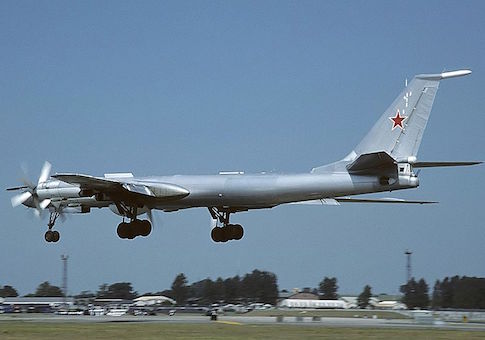Fighter jets from the USS Ronald Reagan scrambled to intercept two Russian bombers that flew within one mile of the carrier during the latest saber-rattling by Moscow.
"There were two Russian Tu-142 Bear aircraft that approached the USS Ronald Reagan on the morning of Oct. 27 … while the Reagan was operating in the Sea of Japan," said Navy Capt. Jeff Davis, a Pentagon spokesman.
Four F/A-18 jets were launched from the carrier to intercept and escort the Russian aircraft, he added.
"The interaction was characterized as safe," Davis said, noting that prudent defensive action was taken by the carrier.
Asked whether the aircraft posed a threat, Davis said: "Anytime there are aircraft operating in close proximity to a U.S. Navy ship, particularly an aircraft carrier, we’re going to take action to launch and make sure we are tracking it very closely."
"But there was nothing to indicate they were posing a direct threat," he said.
During the incident, however, the Russian two aircraft, anti-submarine warfare versions of the Tu-95 Bear nuclear-capable bomber, were flying at a height of only 500 feet and came within a mile of the Reagan.
The encounter in the Sea of Japan was the latest in a series of Russian aerial operations near U.S. ships and aircraft that Pentagon officials have said in the past is "strategic messaging" by Moscow.
Russian has adopted a hostile posture toward the United States first over the deployment of U.S. missile defenses in Europe, and then in response to sanctions and other measures taken against Russia for its military annexation of Ukraine’s Crimea last year.
Senior U.S. military leaders have said Russia is emerging as a major threat to the United States because of its strategic nuclear forces buildup and a new military doctrine under Vladimir Putin, that calls for greater reliance on nuclear forces.
Davis said communications sailors on a warship sailing with the Reagan strike group of ships attempted to radio the two Russian aircraft when they were detected but received no response.
Davis said he is unaware that the United States issued a protest of the maneuver that was similar to other aerial encounters between U.S. ships and aircraft and Russian bombers.
The Russian aerial show of force against a carrier is "not unprecedented," Davis said, but also is not a regular occurrence.
The aerial incident took place five days after Gen. Sergei Shoigu, Russia’s defense minister, announced that Moscow is constructing five military bases in the region, including one on the Kuril Islands, which were seized by the Soviet Union from Japan at the end of World War II.
A Japanese government official said after the Shoigu announcement that Tokyo would protest the Kuril base and insisted that the Kurils, located north of Japan, are Japanese territory.
The Kurils are believed to hold large undersea reserves of gas and oil.
Russia has been building up its military forces in the Pacific and the Arctic in response to the U.S. pivot to Asia after decades of neglect following the collapse of the Soviet Union in 1991.
Russia unveiled a new military doctrine in December that emphasizes protecting interests in the Arctic. The effort includes a new Arctic military command and increased icebreaker fleet.
Earlier aerial activities by Moscow included flights by two Russian Tu-95 strategic bombers that circumnavigated the Pacific U.S. island of Guam twice, once in November and again in December. The island is a major U.S. military hub for the Obama administration’s pivot to Asia.
A Russian Su-27 fighter flew dangerously close to an RC-135 reconnaissance jets near the Sea of Okhotsk in April 2014.
The most recent Russian aircraft intrusion of U.S. air defense zones took place July 4 when two Tu-95 bombers flew within 40 miles of the California coast and communicated a message to U.S. jet interceptor pilots that escorted the bombers out of the area. The message from one of the Russians was "Happy birthday," according to U.S. officials.
The California bomber incursion also took place the same day that President Obama held a telephone conversation with Putin.
A Russian Su-27 fighter jet conducted a dangerous aerial intercept of an RC-135 reconnaissance aircraft over the Black Sea earlier in May. Around the same time, a Russian Su-24 jet interceptor buzzed the destroyer USS Ross in the Black Sea, near occupied Crimea.
